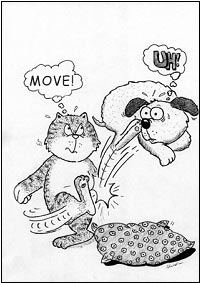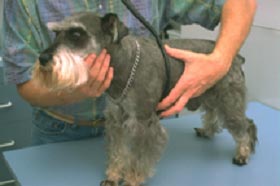It
is not unusual for behavior
problems to develop in older
pets and often there may be
multiple concurrent problems.
It is also important to note
that some of the changes associated
with aging may not seem significant,
but even a minor change in behavior
might be indicative of underlying
medical problems or a decline
in cognitive dysfunction. Since
early diagnosis and treatment
can control or slow the progress
of many disease conditions,
be certain to advise your veterinarian
if there is any change in your
pet's behavior. 
What
are some of the causes of behavior
changes in senior pets?
1.
Many of the problems have similar
causes to those in younger pets.
Changes in the household, changes
in the environment and new stressors
can lead to problems regardless
of age. For instance moving,
a change in work schedule, a
family member leaving the home,
or new additions to the family
such as a spouse or baby, can
have a dramatic impact on the
pet's behavior. In addition,
it is likely most older pets
will be more resistant or less
able to adapt to change.
2.
Older pets are also likely to
develop an increasing number
of medical and degenerative
problems as they age. Any of
the organ systems can be affected
and play a role in the development
of a wide variety of behavior
problems. For example, diseases
of the urinary system and kidneys
can lead to house-soiling. Diseases
of the endocrine organs such
as the thyroid gland and pituitary
gland can lead to a variety
of behavioral and personality
changes. A decline in the senses
(hearing and sight), painful
conditions, and those that affect
mobility may cause the pet to
be more irritable or more fearful
of approach and handling (see
handout on Behavior –
causes and diagnosis of problems
for more details).
3.
As with other organs the brain
is susceptible to age related
degenerative processes that
can affect the pet's behavior,
personality, memory, and learning
ability. When these changes
occur, the pet may show varying
degrees of cognitive decline
(discussed below) and in pets
that are more severely affected,
this might be referred to as
cognitive dysfunction or senility.
Many of these changes are similar
to what occurs in aging humans.
In fact, the amyloid deposits
that are found in the brain
of dogs with cognitive dysfunction
are similar to what is seen
in the early stages of Alzheimer's
disease in people.
How
can I find out why my pet's
behavior has changed?
Regardless
of age, every behavior case
should begin with a complete
veterinary physical examination
and a clinical and behavioral
history. In addition, blood
tests and a urinalysis may be
needed to rule out organ disease
and endocrine imbalances, especially
in the older pet. Sometimes
a more indepth examination of
a particular organ system may
be indicated. Additional laboratory
tests, radiographs, ultrasound,
spinal tests, brain scans, or
perhaps a referral to a specialist
may all be appropriate. A decision
on which tests are needed would
be based on the pet's
age, previous health problems,
any ongoing drug or dietary
therapy and an evaluation of
all of its medical and behavioral
signs and the findings of the
physical exam.
My
pet is quite old. Is there any
point in doing these tests?
What can be done?
 Unfortunately
many pet owners do not even
discuss behavior changes with
their veterinarians since they
feel that the changes are a
normal part of aging and perhaps
nothing can be done for their
dog or cat. This is far from
the truth. Many problems have
an underlying medical cause
that can be treated or controlled
with drugs, diet or perhaps
surgery. Hormonal changes associated
with an underactive or overactive
thyroid gland, diabetes, diseases
of the pituitary gland and testicular
tumors can all lead to dramatic
changes in the pet's behavior
and many of these problems can
be treated or controlled. Degenerative
organ systems can often be aided
with nutritional supplementation
or dietary changes. High blood
pressure, cardiac disease and
respiratory diseases may be
treatable with medication, which
may dramatically improve the
quality and even length of the
pet's life. And drugs
and dietary therapy are also
available that are useful in
the treatment of age related
cognitive dysfunction. Unfortunately
many pet owners do not even
discuss behavior changes with
their veterinarians since they
feel that the changes are a
normal part of aging and perhaps
nothing can be done for their
dog or cat. This is far from
the truth. Many problems have
an underlying medical cause
that can be treated or controlled
with drugs, diet or perhaps
surgery. Hormonal changes associated
with an underactive or overactive
thyroid gland, diabetes, diseases
of the pituitary gland and testicular
tumors can all lead to dramatic
changes in the pet's behavior
and many of these problems can
be treated or controlled. Degenerative
organ systems can often be aided
with nutritional supplementation
or dietary changes. High blood
pressure, cardiac disease and
respiratory diseases may be
treatable with medication, which
may dramatically improve the
quality and even length of the
pet's life. And drugs
and dietary therapy are also
available that are useful in
the treatment of age related
cognitive dysfunction.
What
are some things to look out
for?
Changes
in behavior (see cognitive dysfunction
below), an increase or decrease
in appetite or drinking, an
increased frequency or amount
of urination, loss of urine
control (dribbling urine, bedwetting),
changes in stool consistency
or frequency, skin and hair
coat changes, lumps and bumps,
mouth odor or bleeding gums,
stiffness or soreness, excessive
panting, coughing, changes in
weight (increase or decrease),
and tremors or shaking are some
of the more common signs that
should be reported, should they
develop in your pet.
What
is cognitive dysfunction and
how is it diagnosed?
It
is generally believed that,
as in people, a dog or cat's
cognitive function tends to
decline with age. If your dog
has one or more of the signs
below and all potential physical
or medical causes have been
ruled out, it may be due to
cognitive dysfunction. Of course,
it is also possible that cognitive
dysfunction can arise concurrent
with other medical problems,
so that it might be difficult
to determine the exact cause
of each sign. Over the past
few years the signs commonly
attributed to cognitive dysfunctions
have been described by the acronym
DISH (Disorientation, alterations
in Interactions with family
members, Sleep-wake cycle and
activity level changes or House
soiliing). However this may
not be a sufficiently complete
list to describe all of the
categories in which a decline
in cognitive function might
be seen. These might include:
| a)
|
Disorientation
(such as getting lost in
familiar areas such as the
home or yard) |
| b)
|
Social
interactions might be altered
between the pet and owner
or pet and other pets –
some pets may appear to
be more clingy while others
might be disinterested or
even irritable when petted
or approached |
| c) |
Anxiety
might be increased |
| d)
|
Activity
levels often decrease so
that the pet is seen sleeping
more or less playful and
exploratory. However some
pets also become more active
and restless with pacing,
or even stereotypic behaviors
such as licking or bouts
of barking |
|
e) |
Appetite
may be affected with some
pets showing a disinterest
in food and others having
a more voracious appetite
|
| f) |
Altered
sleep cycles with increased
waking or restlessness at
night |
| g) |
Altered
learning or memory as demonstrated
by an inability to retrain,
loss of performance (such
as commands, working ability,
or previous training) or
house soiling (no longer
can remember where to eliminate
or how to signal) |
In
one study of dogs that were
11-16 years of age, owners specifically
questioned regarding signs of
cognitive dysfunction reported
that 28% of 11 to 12 year old
dogs and 68% of 15 to 16 year
old dogs exhibited at least
one of the signs above. However,
it's important to note
that these are signs noticed
by pet owners in comparison
to when their dog was younger.
Research has shown that if you
were to try and train your dog
on some new learning tasks,
that after about 8 years of
age many dogs may begin to show
a decline in memory and learning
ability around this age. Owners
of older cats also noted many
of these signs listed above
but they tended to arise at
a little older age (e.g. 15
years and older) Treatment options
tend to be most effective at
slowing or reversing decline
when they are instituted early
in the course of disease. Therefore,
be certain to report any of
these signs to your veterinarian
immediately.
Do
pets get Alzheimer's?
Many
of the same changes and lesions
associated with Alzheimer's
disease in people have also
been recognized in dogs and
cats. Should multiple behavior
problems develop and these changes
progress to the point where
the dog or cat is no longer
a "functional" pet,
the condition may be consistent
with senility or dementia of
the Alzheimer's type.
Can
geriatric behavior problems
be treated?
In
many cases the answer is yes.
Of course if there are medical
problems contributing to the
behavior changes, the problem
may not be treatable. The key
therefore is to report changes
and bring in your pet for assessment
as soon as new problems arise.
Dogs
that develop behavior problems
due to underlying medical conditions
may need alterations in their
schedule or environment in order
to deal with these problems.
If the condition is treatable
and can be controlled or resolved
(e.g. Cushing's disease,
infections, painful conditions)
then, as discussed, you must
be prepared to retrain the dog,
since the new habit may persist.
For example, the house-soiling
pet may have less duration of
control due to its medical problems.
If these conditions cannot be
controlled, then the pet's
schedule (more frequent trips
outdoors), or environment (installing
a dog door, paper training)
may have to be modified. With
conditions that affect a cat's
mobility, adjustments may be
needed to the pet's environment,
litter box placement, or type
of litter box, (e.g. a lower
sided box).
In
cognitive dysfunction, an increase
in a neurotoxic protein called
beta amyloid, an increase in
damage due to toxic free radicals,
a loss of neurons, and alterations
in neurotransmitters such as
dopamine may be responsible
for many of the behavior changes.
Both drug therapy and dietary
therapy are now available that
might improve these signs and
potentially slow the decline.
Again early diagnosis and intervention
is likely to have the greatest
effects.
Selegiline
is a drug that has been licensed
for the treatment of cognitive
decline in dogs in North America.
It is classed as an MAOB inhibitor
but its action may be to enhance
neurotransmitter function such
as noradrenaline and dopamine,
to help reduce free radical
damage in the brain and perhaps
as a neuroprotective drug (see
details in our handout on drug
therapy). Many of the signs
listed above (DISH) may be improved
by treatment with selegiline.
Another
method of managing senior behavior
problems is a prescription diet
that is designed to protect
against and possibly reverse
damage due to toxic free radicals.
It is enhanced with a variety
of antioxidants including vitamin
E, Selenium, vitamin C and fruits
and vegetables. It is also supplemented
with essential fatty acids in
the form of fish oils and some
factors to help the cell's
mitochondria function more efficiently
including carnitine and lipoic
acid. The diet has been shown
to improve learning ability
and memory in old dogs and improve
many of the clinical signs listed
above (i.e. DISH).
 There
are a number of other medications,
some licensed for use in European
countries (such as nicergoline
and propentofylline). These
drugs have been developed for
use in human geriatric patients.
They are behavior modifying
drugs that might also enhance
cognitive function by increasing
blood flow through the brain
or by enhancing neurotransmitter
function. There
are a number of other medications,
some licensed for use in European
countries (such as nicergoline
and propentofylline). These
drugs have been developed for
use in human geriatric patients.
They are behavior modifying
drugs that might also enhance
cognitive function by increasing
blood flow through the brain
or by enhancing neurotransmitter
function.
It is important to note however
that once new habits are learned,
retraining and changes to the
environment may also be needed
to resolve the problem. For
example, in addition to drug
therapy, dogs that have begun
to eliminate indoors will need
to be retrained much like a
puppy that has begun to eliminate
indoors.
This client
information sheet is based on
material written by Debra Horwitz,
DVM, DACVB and
Gary Landsberg, DVM, DACVB.
© Copyright 2002 Lifelearn
Inc. Used with permission under
license. March 11, 2004. |